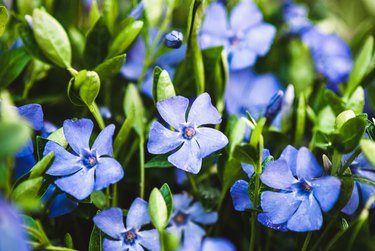
Creeping myrtle (Vinca minor) is one of those rare perennial evergreen ground covers that flower. Its small, brilliant blue blossoms make this tough ground cover very appealing, and its easy-care ways cement a gardener's affection. Once the plant gets started, it pretty much takes care of itself, although you may have to take steps to prevent it from spreading out of control.
Understand Creeping Myrtle's Growth Habit
Video of the Day
Creeping myrtle, also known as vinca, spreads by above-ground stems called stolons that trail in a mat or spread outward from a mound. Each plant in a mat grows up to 6 inches tall but spreads up to 3 feet wide.
Video of the Day
Creeping myrtle leaves are lustrous dark green on top with slightly white veins. Solitary blue-purple flowers with five pinwheel-like petals bloom in early spring, but you can buy cultivars that have white or reddish-lavender flowers. Creeping myrtle will grow in U.S. Department of Agriculture plant hardiness zones 4 through 8.
Buy and Transplant Nursery Seedlings
When you go to the garden store in search of creeping myrtle, you may find it under the name periwinkle. If you aren't sure if it is creeping myrtle, double-check the genus and species name.
You can usually buy rooted plugs in peat pots or cell packs, although they may come in containers. Plant the plugs 12 inches apart and mulch them. Field-grown plants at least 2 years old or plants grown in pots should be planted about 9 inches apart. Transplant in early spring or in September.
Cultivate Creeping Myrtle
Creeping myrtle grows best in evenly moist, rich, well-drained soil with a pH of 6 to 8, although it will adapt to average soil. It prefers partial shade but will grow in full shade and makes a good ground cover beneath shade trees. Full sun will reduce its vigor and may turn its leaves yellow. Growing it in USDA zone 8 requires lots of shade.
Water creeping myrtle evenly for the first growing season to help the transplants get established. If the soil has enough moisture for mature creeping myrtle to grow, do not irrigate it frequently. Apply 6 to 8 pounds of 10-10-10 fertilizer in the spring per 1,000 square feet. Beware that creeping myrtle may spread rapidly under the best growing conditions.
Look Out for Fungal Stem Blight
Creeping myrtle is only rarely infected by most diseases that afflict ground covers. However, fungal stem blight is a major problem. The fungus spreads through moist soil, striking both newly planted creeping myrtle and vigorous, mature plants. It typically appears in wet spring weather when the temperature is between 50 and 65 degrees Fahrenheit and sometimes in wet autumn weather. Watch for dark lesions that circle overwintered runner stems at the ground.
You can't cure stem blight once it hits, but you can take steps to prevent it. Plant only disease-free, vigorous plants. Surround the new plants with black plastic mulch. Hold the mulch in place with gravel or rough-ground corn cobs and perforate it every 4 to 6 inches.
Prevent Escape From Cultivation
Creeping myrtle can be invasive. It propagates extremely easily in every possible way. If it travels outside of the garden, it may form dense mats on forest floors, crowding out other plants. Control its spread by mowing or cutting. If necessary, ask the garden store for an appropriate herbicide.